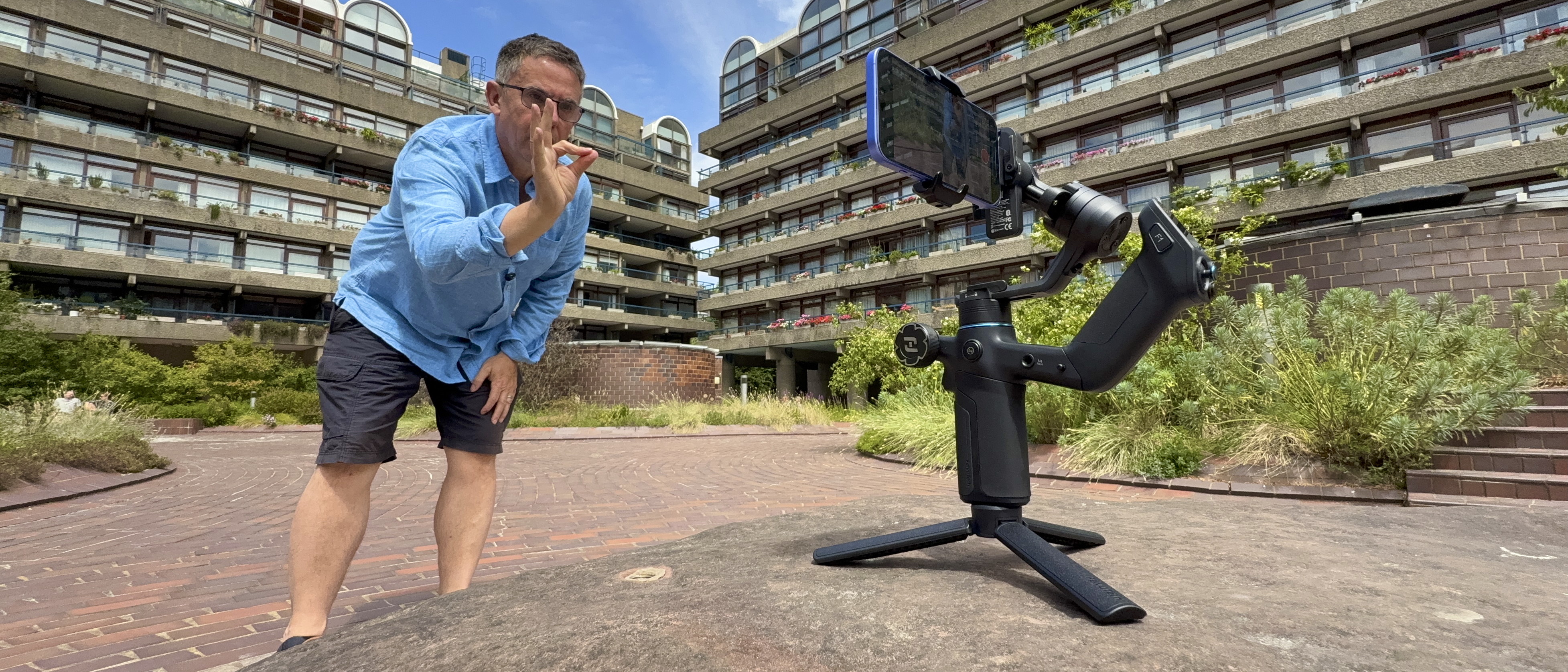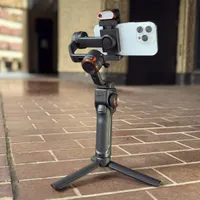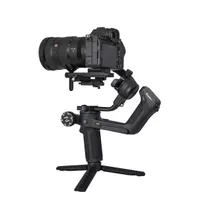Digital Camera World Verdict
The Scorp Mini 3 Pro Kit is a solidly built three-axis stabilizer that frees you to make a wide range of cinematic camera moves via your smartphone or mirrorless camera. You can change modes via touchscreen or by using more tactile buttons and display indicator lights. I found that the freedom of movement provided by the Scorp Mini 3 Pro inspired me creatively to capture cinematic tilts, hands, rolls, and point-of-view shots when shooting a model on location. It performed smoothly in multiple test shoots, and it now replaces the Hohem iSteady M7 as my ‘go-to’ smartphone gimbal!
Pros
- +
Effective long-range AI-tracker
- +
Multi-function knob to finetune axes
- +
Joystick for smooth, controlled moves
- +
Solid build and reliable performance
- +
Cooling fan on smartphone mount
Cons
- -
Default AI tracking leaves too much headroom
Why you can trust Digital Camera World
Many cameras and smartphones use a combination of hardware-enabled OIS (Optical Image Stabilization) and software-powered digital stabilization to smooth out bumps and shakes in handheld footage. OIS uses a gyroscope to detect camera movement, which it then counteracts by physically moving elements in the lens or camera sensor. Digital (or 'enhanced' stabilization) crops the shot slightly and then transforms the image to counteract shake frame-by-frame. Indeed, with a modern smartphone, such as the iPhone 16 Pro, you can produce tripod-steady pans and tilts when filming handheld, or capture smooth tracking shots as if using a camera mounted on rails. So why bother buying a gimbal, such as the FeiyuTech Scorp Mini 3 Pro?
Well, for starters, a gimbal enables you to use the full frame of footage (without it being cropped around the edges by digital stabilization). It can be a challenge to hold a camera level while making a move, leading to tilted horizons (which you then have to straighten in the edit). The roll motor on a gimbal automatically rotates to keep the horizon level at all times, so you can focus on making the right camera moves and capturing an aesthetically pleasing composition.
What I really like about using gimbals is the way that they free you to make cinematic camera moves, such as pans, tilts and tracking shots, as well as more creative POV (Point of View) shots, where the camera can tilt, pan and roll in a more organic ‘floaty’ way! Check out the video in the Performance section below to see how the Scorp Mini 3 Pro can help you unleash your inner Kubrick!
The Scorp Mini 3 Pro is designed to carry smartphones, action cameras, and mirrorless cameras up to a payload (camera and lens combination) of 2kg (4.4lbs). If you have a particularly heavy DSLR payload, then check out our heavy-lifting gimbal buying guide. Alternatively, we also have a buying guide dedicated to smartphone gimbals.
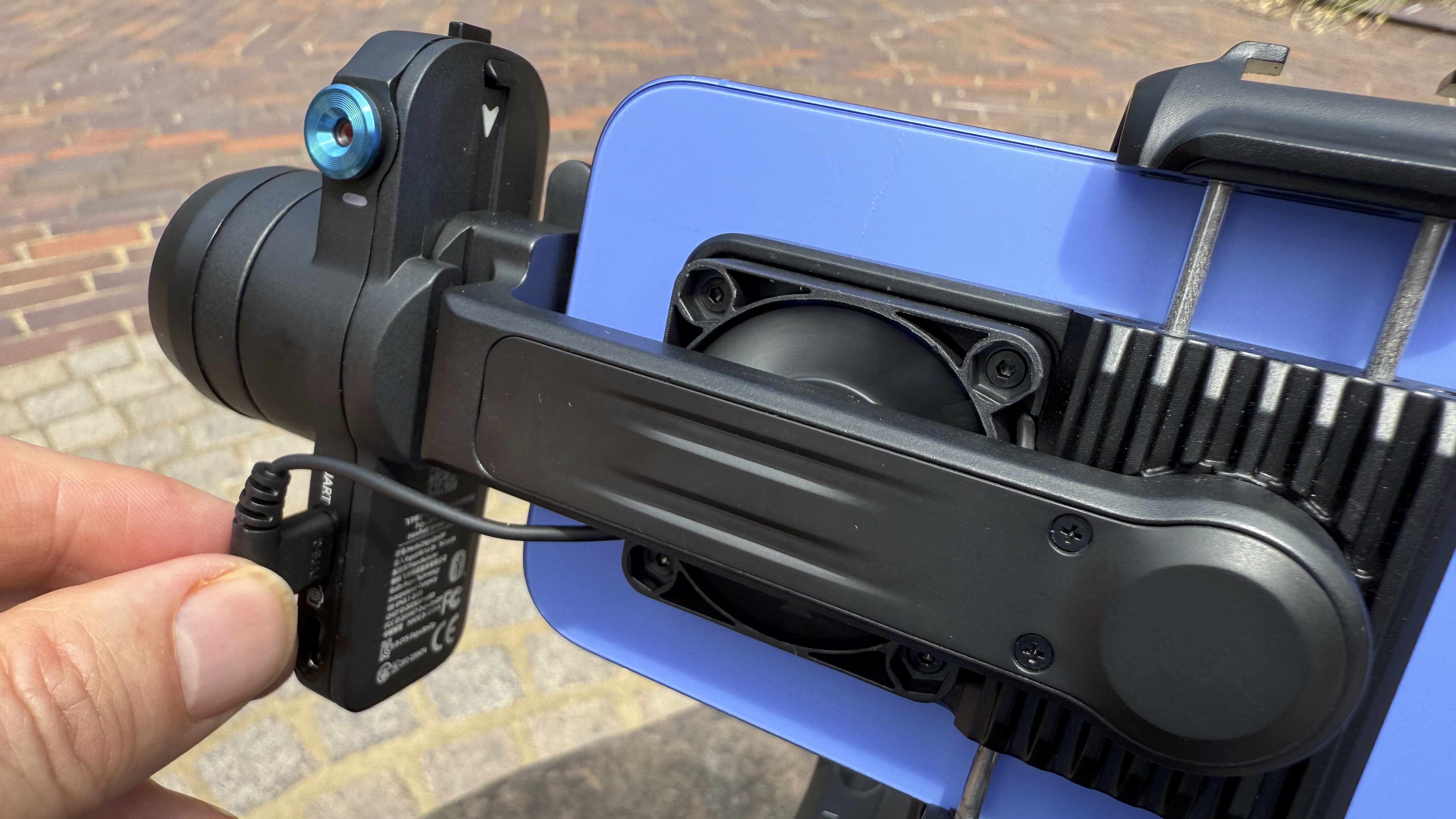
FeiyuTech Scorp Mini 3 Pro Kit: Specifications
Materials | Synthetic macromolecular resin, aluminum alloy |
Rotatable Range | Tilt 313° (with limitation); Roll 315° (with limitation); Pan 360° (unlimited) |
Screen | 1.3-inch OLED touchscreen |
Max Payload | About 2kg / 4.4lbs (well balanced) |
Shutter Connection | Mirrorless / Compact Camera – Cable and Bluetooth; Smartphone – Bluetooth; Action camera – Bluetooth |
AI Tracking | Built-in AI tracking module 4.0 with 15% Wider Tracking View; 0.003s Response Time; approximate tracking distance up to 18 meters |
Battery Capacity | 4500mAh (approx 14 hours) |
Weight | 1kg (2.2lbs) |
App | Feiyu SCORP |
FeiyuTech Scorp Mini 3 Pro Kit: Price
The official retail price for the FeiyuTech Scorp Mini 3 Pro Kit that I tested for this review is US$299 available on the Feiyutech store. The Kit version contains extras such as a padded carry case, an LED to mount on the gimbal, and an extension pole for capturing higher-angle views when performing moves such as a low-to-high-angle crane shot. However, the extras shipped with the Kit version aren’t essential, so you can save $30 by purchasing the standard Scorp Mini 3 Pro for US$269.
The Scorp Mini 3 Pro costs US$70 more than the older Scorp Mini 2, but I think that the extra cost is well worth it. The newer model features a range of upgrades, such as the ability to carry a heavier payload (4.4lbs on the Scorp Mini 3 Pro versus a punier 2.7lbs on the Scorp Mini 2). The newer model’s version 4.0 AI tracking module is more effective than the tracker on the Mini 3, too – see the Design and Handling section below for more information on that useful feature.
If you’re on a budget and are primarily a smartphone user, then the older Scorp Mini 2 is worth considering. It has the same-sized 1.3-inch OLED touchscreen found on the Mini 3, though a slightly shorter battery runtime of 10 hours (compared to the Mini 3’s 14 hours). For alternatives to the Scorp Mini 3 Pro, check out my Alternatives section near the bottom of this review.
The best camera deals, reviews, product advice, and unmissable photography news, direct to your inbox!
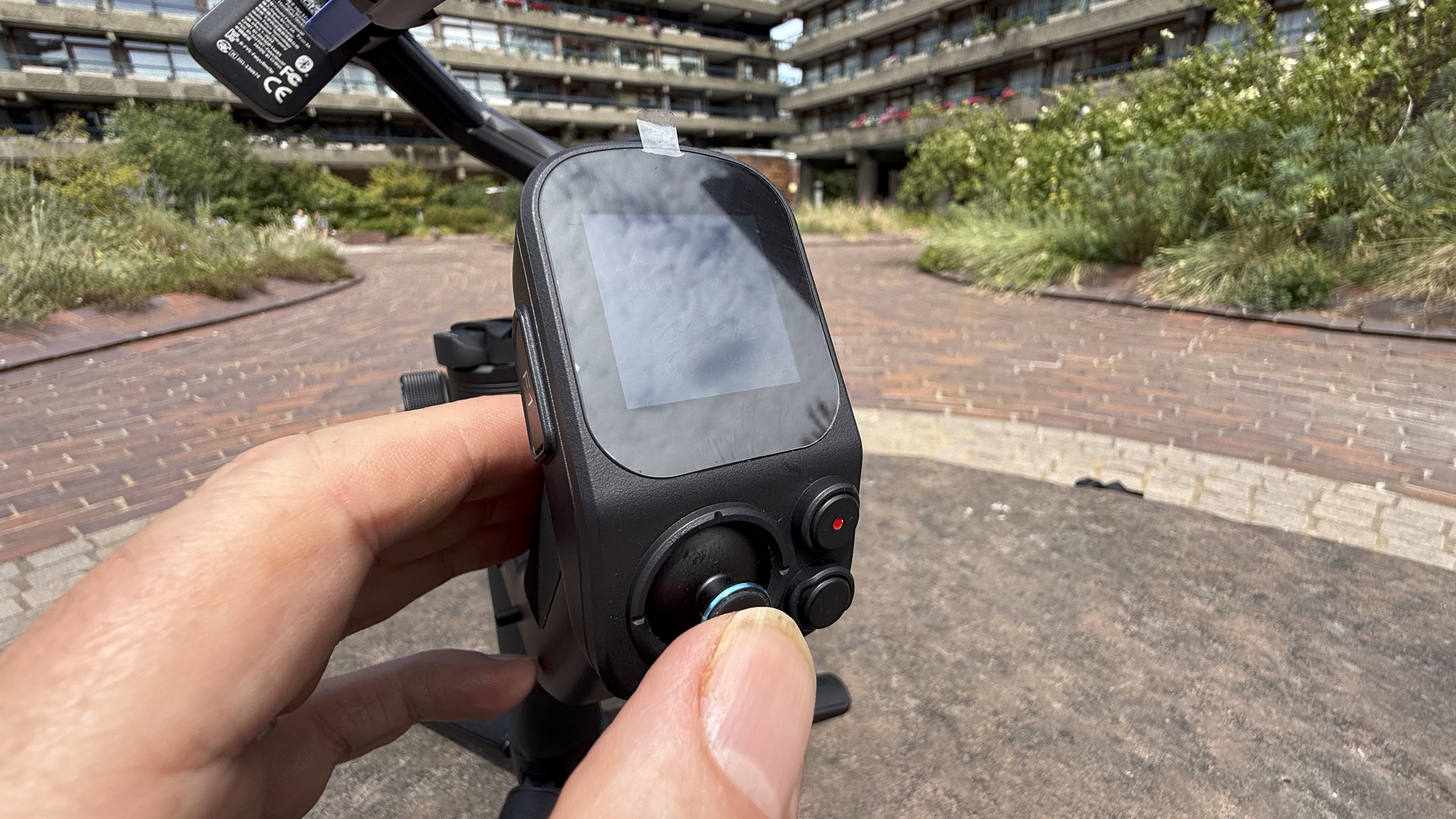
FeiyuTech Scorp Mini 3 Pro Kit: Design & Handling
Let’s start by comparing the FeiyuTech Scorp Mini 3 Pro with its predecessor, the Scorp Mini 2. The newer model can carry a heavier payload of up to 4.4lbs compared to the 2.7lbs of the Mini 2, which should make the Scorp Mini 3 Pro more attractive to mirrorless camera users as well as smartphone filmmakers. The Scorp Mini 3 Pro should perform for longer, too, with a claimed runtime of 14 hours (compared to 10 on the Mini 2). I performed two test shoots with the Scorp Mini 3 Pro, one of which spanned a day-long event, and there was never any issue with it running out of juice!
You control both Scorp Mini models with an identically sized 1.3-inch OLED touchscreen. This enables you to swipe and tap to summon a range of shooting modes (such as Pan/Follow), or make the gimbal perform an auto-tune to ensure that the pan, tilt, and roll axes are perfectly balanced with your camera.
Both Scorp Minis have a built-in AI sensor that causes the gimbal to pan and tilt to follow your every move. However, the newer Scorp Mini 3 Pro has the upgraded 4.0 AI sensor (compared to the Scorp Mini 2’s version 2.0). The version 4.0 sensor can keep on tracking you up to a distance of 18 metres, whereas the version 2.0 sensor only has a range of 8 metres. The Scorp Mini 3’s AI sensor also has a tracking range that is 15% wider than the Scorp Mini 2’s tracker. One really useful design feature that has been added to the Scorp Mini 3 Pro is a collection of status lights that help you more clearly see what mode you’re shooting in, as well as showing Bluetooth and battery status. Nice touch!
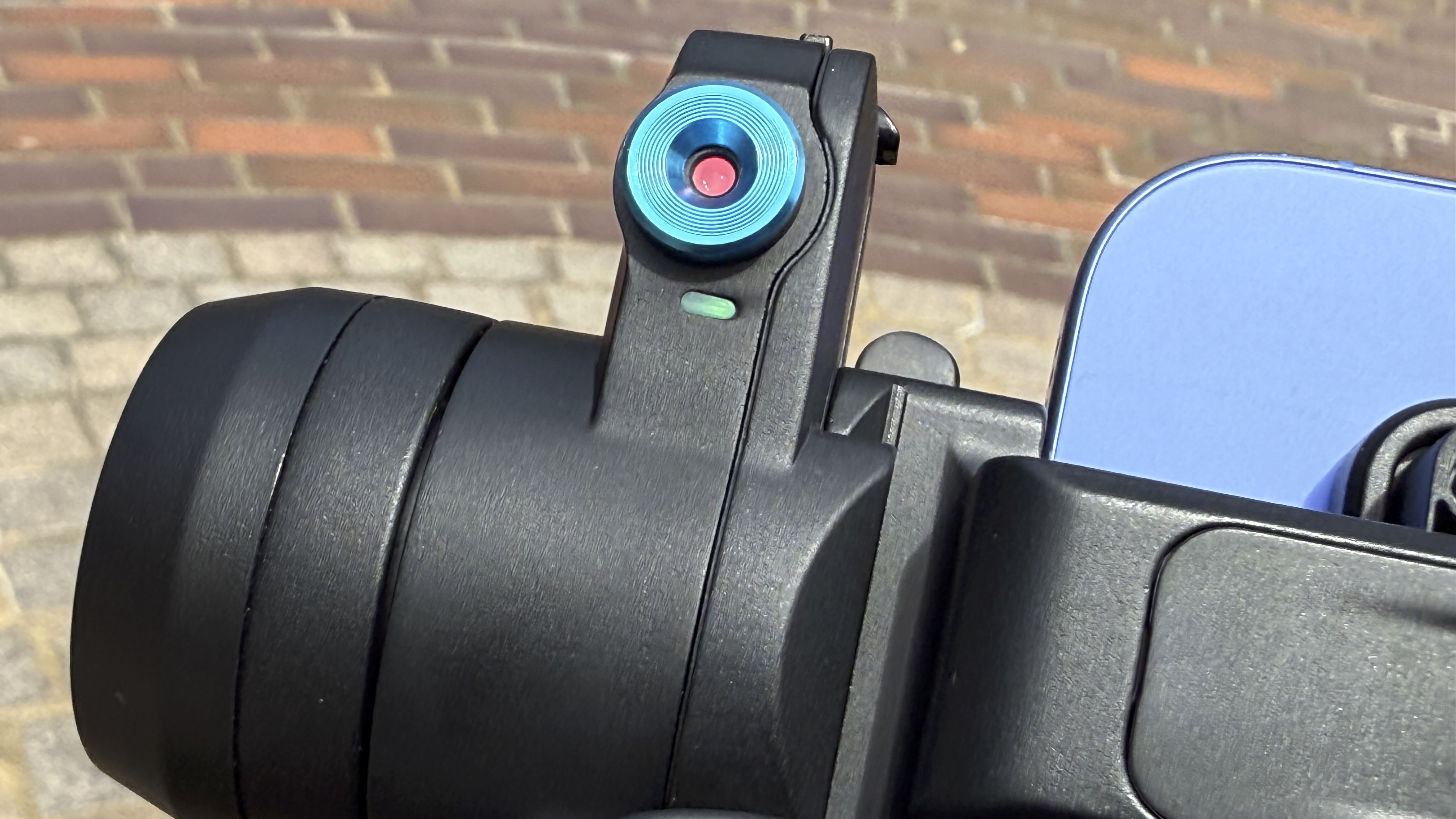
The Scorp Mini 3 Pro is a slightly heftier bit of kit than the Scorp Mini 2. When you take it out of the box, it feels satisfyingly solid and heavy, courtesy of its synthetic macromolecular resin and aluminum alloy build. The Scorp Mini 3 weighs in at 1kg (2 lbs), which is a little heavier than the 852g (1.9lbs) of its predecessor. However, once the camera is mounted on the gimbal and you hold it with two hands – one grabbing the grip and the other supporting the weight via the underslung handle – then it’s almost effortless to move the gimbal-mounted camera through a range of moves. Indeed, with my iPhone 16 Plus attached to the Scorp Mini 3 Pro, I was able to comfortably hang the whole rig from one finger via the underslung handle.
The hook-shaped underslung handle is a great design feature as it enables you to perform really low-angle tracking shots or crane up from a low to high angle. It also has a joystick built in and a touch-sensitive OLED screen to adjust various modes and presets. Unlike the underslung handle on the Scorp Mini 2, the newer model’s handle can be completely detached. This enables you to use the joystick to remotely pan and tilt the gimbal-mounted camera from a distance when it is standing on its mini-tripod. This is another innovative design improvement for the Scorp Mini 3 Pro, though admittedly, I didn’t encounter a situation where I needed to control the gimbal remotely during my testing of it.
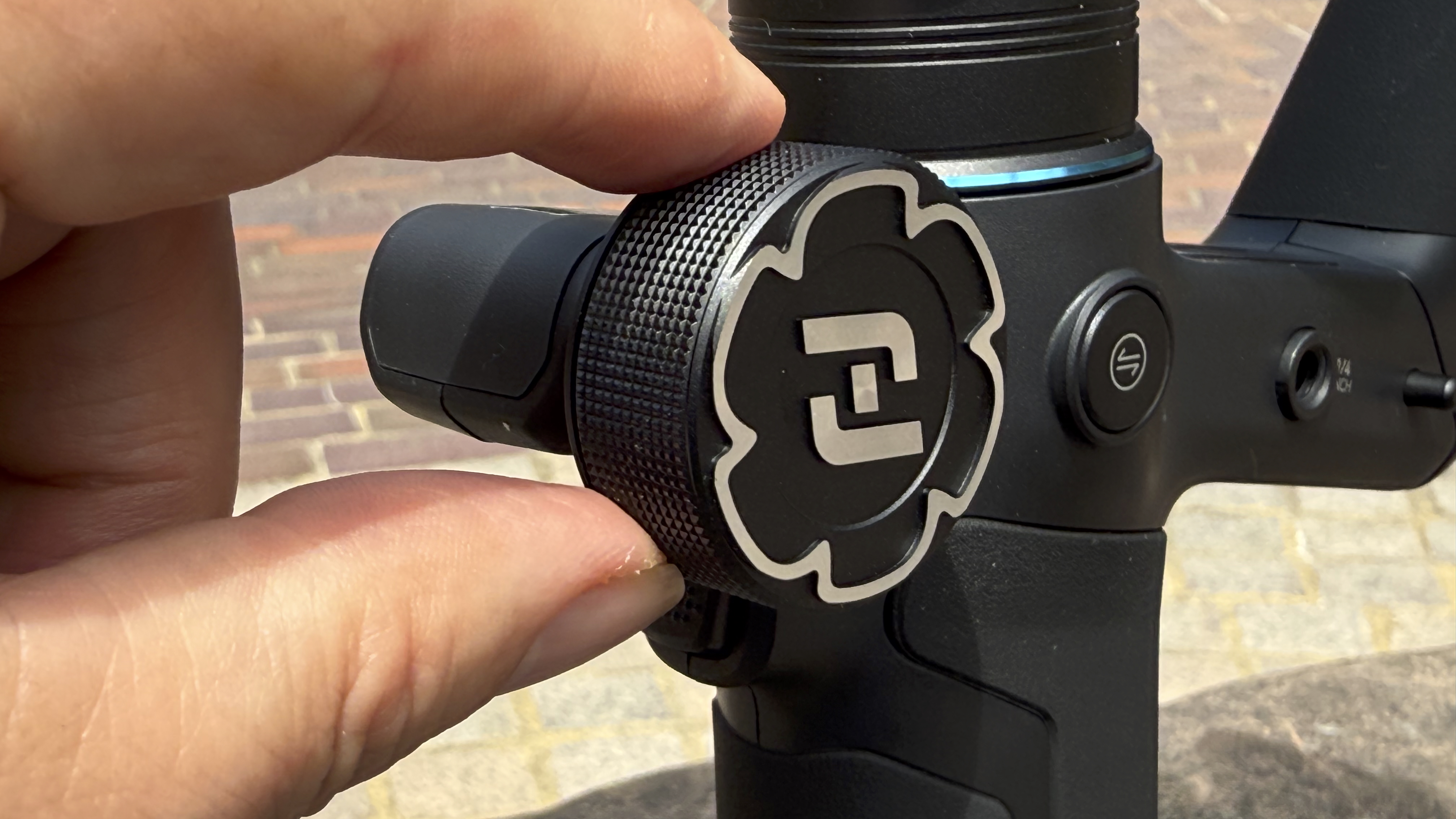
FeiyuTech Scorp Mini 3 Pro Kit: Performance
I started my Scorp Mini 3 Pro test at one of my favorite haunts – the Barbican Centre in London. Here I recorded the intro to my video review: by popping the Scorp Mini 3 Pro onto its mini tripod, I could talk to camera from a distance.
The gimbal ships with a universal smartphone mount that slides into the main device via a quick-release mount. I was intrigued and pleased to see that the smartphone mount had a built-in fan that is powered when you plug it into the gimbal via the mount’s USB-C cable. When shooting on my iPhone 16 Pro on previous occasions, it has occasionally overheated and temporarily stopped working, so the smartphone mount’s built-in fan could save the day, especially in a heatwave! To record my voice clearly from a distance, I plugged in a receiver from the Boya Mini Kit into my iPhone. The receiver is so small and light that it didn’t cause any balance problems when the iPhone was mounted on the Scorp Mini 3 Pro.
After making an OK hand gesture to the gimbal, the Scorp Mini 3 Pro was able to pan and tilt to follow my every move, courtesy of its built-in AI tracker. This gave me the freedom to walk and talk while the gimbal acted as a camera operator, moving the camera in a smooth and organic way, though the AI sensor did have a tendency to put my face in the centre of the frame, when I would have preferred to have less space above my head. I tried manually tweaking the angle of the gimbal with the joystick, but this composition was overridden by the AI tracker. I’ve since learned that you can train the AI-sensor to accept a re-framed comparison by making a ‘Double-L’ gesture, though I didn’t know this on my shoot.

To make some cinematic moves with the Scorp Mini 3 Pro, I met up with a regular model I work with, Maddy, at Canary Wharf in London. I was a bit nervous about shooting in Canary Wharf because, unlike the Barbican Centre, it is not a public location, so I was more likely to be ‘moved on’ by security personnel. Security guys are usually ‘triggered’ by seeing larger mirrorless or DSLR cameras – especially on a tripod or stabilizer – so I decided to mount my more-discrete iPhone 16 Plus on the Scorp Mini 3 Pro.
My first shot involved Maddy walking backwards through the crowds of commuters. I planned to reverse the footage so that she would be walking forwards while the world walked backwards, like in the movie Tenet! I set the Scorp Mini Pro to PTF (Pan, Tilt, Follow) mode so that it would easily tilt up to a skyscraper at the end of the shot. When the footage was revised we started on the skyscraper, then tilted down to walk backwards while Maddy walked towards the camera. Check out the video to see the shot.
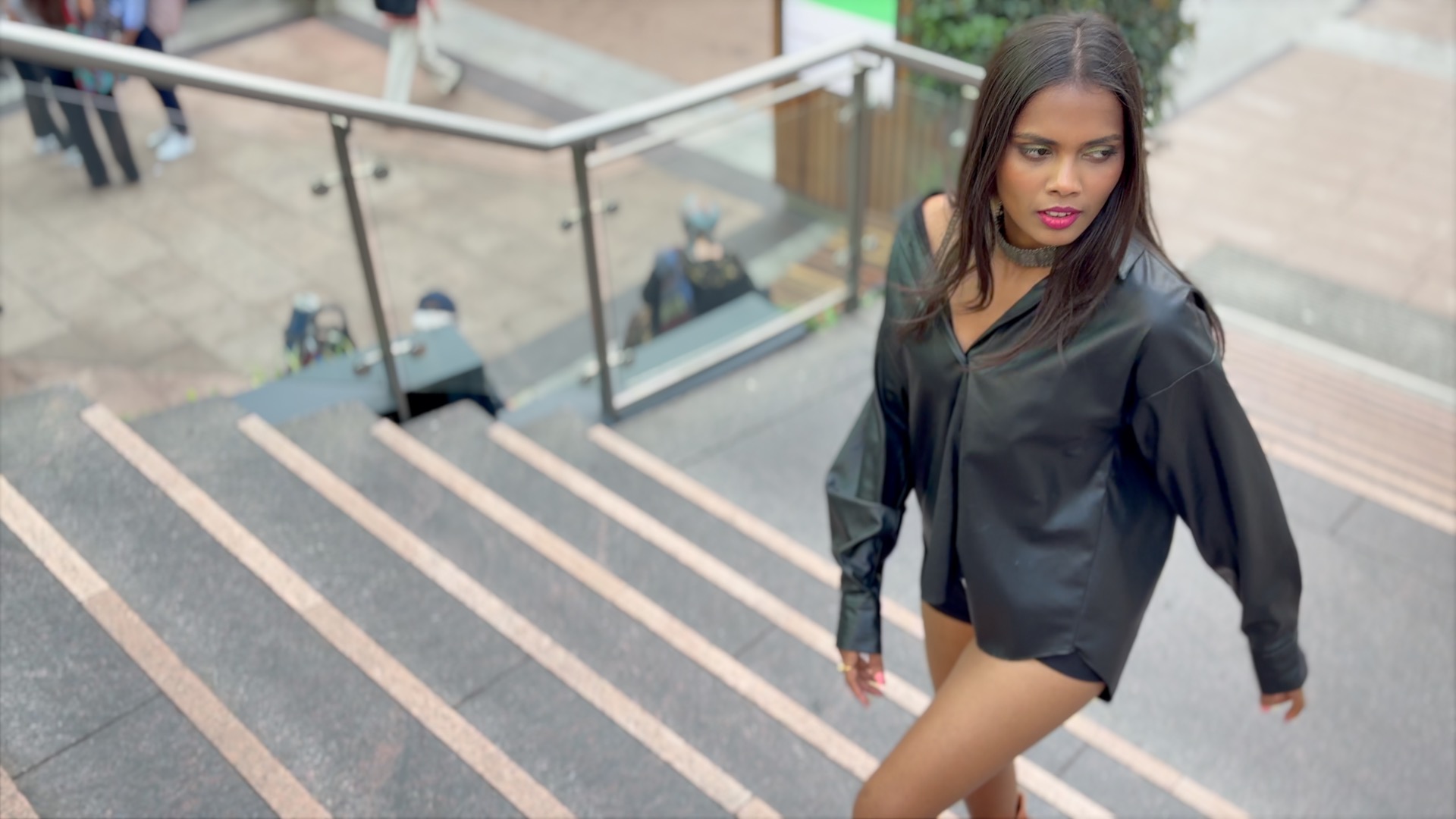
I performed a variety of classic camera moves while filming Maddy in a range of locations. These included sideways tracking shots, dollying forwards or backwards, and dramatic cranes from low to high angles. As well as PTF, I tried out various modes such as POV. This causes the camera to roll as well as tilt and pan, so it captures an effective Point of View clip. You can change modes by tapping and swiping on the sling handle's OLED screen, but I found it quicker and easier to tap the physical mode button. Little icons on the body of the gimbal lit up to indicate which mode was currently selected. I also found the little joystick very useful for fine-tuning composition, especially when I was shooting very-low-angle shots of Maddy walking under a huge steel crane.
I have often noticed, when filming with an iPhone mounted on a gimbal, that the little horizon level indicator in the Camera app is slightly tilted. This can be annoying, as I know that I’ll have to rotate the clip slightly in Final Cut Pro to straighten the horizon. The Scorp Mini 3 Pro has a handy control wheel that you can program to fine-tune the tilt, roll or pan axes. I set the wheel to control roll via the touchscreen menu, so I was then easily able to keep the horizon level. You can also control a wide range of gimbal properties via the companion Feiyu Scorp smartphone app, such as changing modes or fine-tuning balance. You can even remotely control the pan and tilt axes by panning and tilting the smartphone!
After shooting Maddy in London, I took the Scorp Mini 3 Pro to film a classic car event in Scotland. The location was very crowded, and I noticed one videographer struggling to lug a large tripod and chunky camera around in the baking heat. By using my iPhone mounted on the Scorp Mini 3 Pro I was able to move around the location without getting in the way (or breaking into a sweat!). Check out this review’s supporting video to see my gimbal-assisted cinematic footage of Maddy and my documentary-style footage of the car event. I’m sure that you’ll be impressed with its performance!
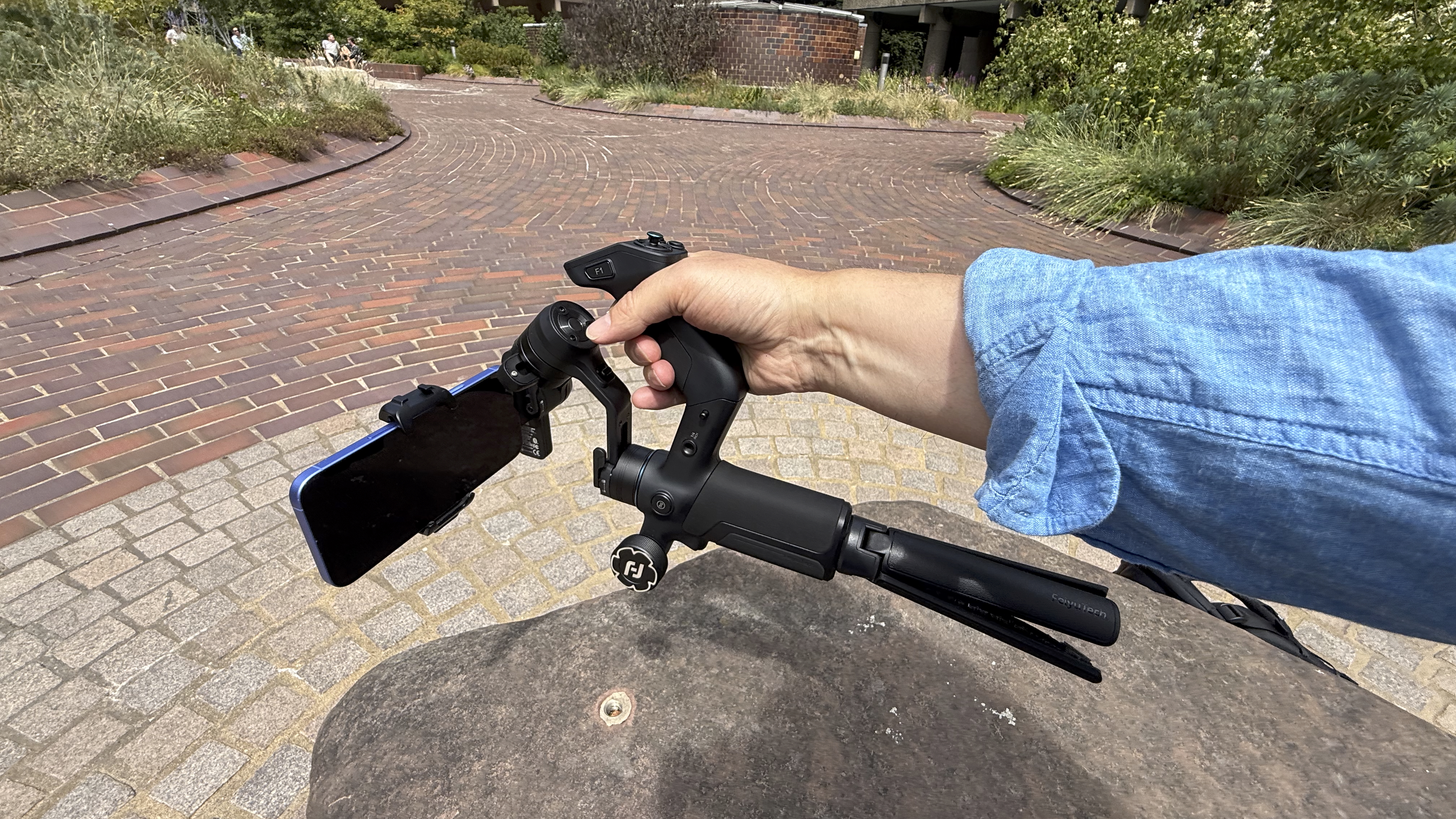
FeiyuTech Scorp Mini 3 Pro Kit: Verdict
I loved using the Scorp Mini 3 Pro. It enabled me to perform a range of cinematic camera moves effortlessly, such as pans, tilts, rolls, tracks, and cranes with my iPhone Pro Max. This freedom of movement inspired me to get creative on location and capture a collection of clips that I could edit together to tell a story in a cinematic way. My model, Maddy, also enjoyed contributing ideas for composition and camera moves. I found that having the freedom to make a range of smooth camera moves was a springboard to creative experimentation.
The Scorp Mini 3 Pro was also useful for capturing more conventional videography, such as recording ‘talking head’ interviews. By not being constrained by a chunky tripod, I could add subtle camera moves to make conventional interviews look more interesting. Thanks to its mini tripod and AI-tracker, the Scorp Mini 3 Pro can also act as an independent camera operator, which is great if you like to work alone when shooting intros for your social media channel. Some gimbals can be a struggle to balance but the Scorp Mini 3 Pro was up and running in seconds, and there was no hint of judder or shake at any time during my multiple test shoots.
Features ★★★★★ | The upgraded version 4.0 AI tracker has a 15% wider tracking view than the previous Scorp Mini and can keep track of you up to 18m away. |
Design ★★★★★ | The OLED screen enables you to take control via taps and swipes, or you can use physical buttons to change modes and fine-tune the roll, tilt and pan axes. |
Performance ★★★★★ | The Scorp Mini 3 Pro enabled me to ‘float’ my iPhone 16 Max through a wide range of cinematic moves without any shake or judder. |
Value ★★★★★ | The Scorp Mini 3 Pro costs about the same as the excellent Hohem iSteady M7, but its more solid build gives it the edge. |
Alternatives
The Hohem iSteady M7 is a close match to the Scorp Mini 3 Pro in terms of price and functionality; both have a built-in AI tracker. The iSteady also has a control knob, like the Scorp Mini 3 Pro. The Hohem iSteady M7 has an extra trick up its sleeve in its ability to send a live feed from the AI tracker to a monitor on the rear of the gimbal, so you don’t have to use a smartphone’s inferior front-facing camera when filming a selfie. However, it does lack the built-in cooling fan found on the Scorp Mini 3 Pro’s smartphone mount.
Read the full Hohem iSteady M7 review
You may be impressed with the specifications of the Scorp Mini 3 Pro, but worried that it won’t carry your heavier DSLR. It’s worth exploring the Scorp 2 as it can carry a payload up to 2.5kg / 5.51lbs (compared to the Scorp Mini 3 Pro’s lighter 2kg / 4.4lbs.). The Scorp 2 also boasts the tactile control knob and built-in AI tacking.
Read the full FeiyuTech Scorp 2 review
George has been freelancing as a photo fixing and creative tutorial writer since 2002, working for award winning titles such as Digital Camera, PhotoPlus, N-Photo and Practical Photoshop. He's expert in communicating the ins and outs of Photoshop and Lightroom, as well as producing video production tutorials on Final Cut Pro and iMovie for magazines such as iCreate and Mac Format. He also produces regular and exclusive Photoshop CC tutorials for his YouTube channel.
You must confirm your public display name before commenting
Please logout and then login again, you will then be prompted to enter your display name.
